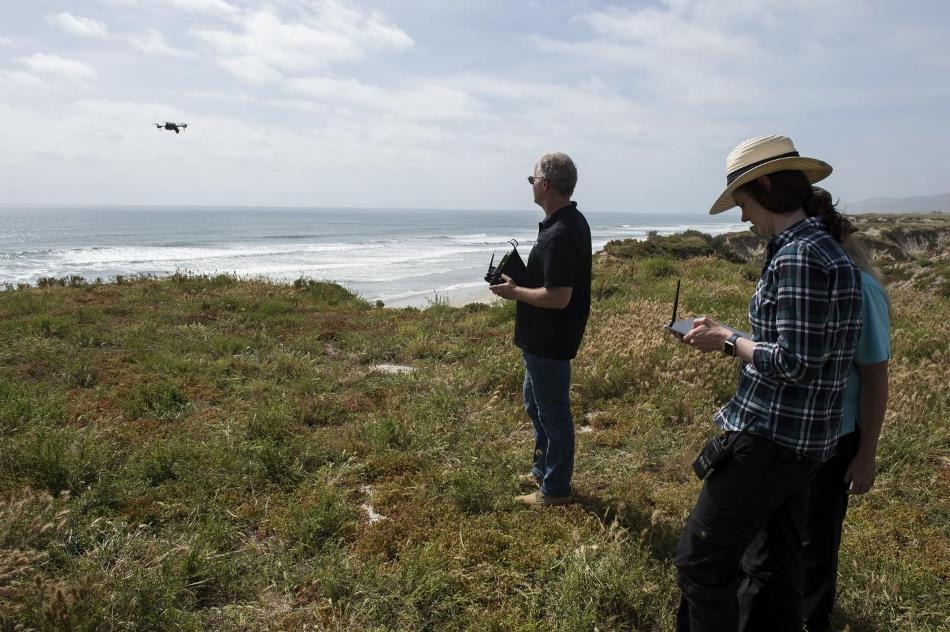Jun 2 2017
A new way to detect submerged and buried mines was unveiled by Dr Rosemarie Oelrich and Dr Cory Stephanson during a recent technology demonstration at Marine Corps Base Camp Pendleton.
 Cory Stephanson, president and CEO of Broadband Discovery Systems, Inc., launches a small quadrotor platform as Dr. Rosemarie Oelrich, scientist, Naval Surface Warfare Center Carderock, uses a handheld Android device to monitor data during the Ship-to-Shore Maneuver Exploration and Experimentation (S2ME2) Advanced Naval Technology Exercise (ANTX) 2017 at Marine Corps Base Camp Pendleton, Calif. CREDIT: (U.S. Navy photo by John F. Williams/Released)
Cory Stephanson, president and CEO of Broadband Discovery Systems, Inc., launches a small quadrotor platform as Dr. Rosemarie Oelrich, scientist, Naval Surface Warfare Center Carderock, uses a handheld Android device to monitor data during the Ship-to-Shore Maneuver Exploration and Experimentation (S2ME2) Advanced Naval Technology Exercise (ANTX) 2017 at Marine Corps Base Camp Pendleton, Calif. CREDIT: (U.S. Navy photo by John F. Williams/Released)
Oelrich, a Scientist at Naval Surface Warfare Center (NSWC) Carderock’s Combatant Craft Division, and Stephanson, President and Chief Executive Officer of Broadband Discovery Systems (BDS), stared at an Android tablet exhibiting search data from an unmanned aerial drone they had recently flown. The screen of the device glowed as a green fluorescent map appeared, splashed with red clusters of different shapes and sizes.
“See that large cluster?” asked Stephanson. “That’s the dummy mine we buried. The smaller blotches near it are construction rebar we found nearby. The drone detected and localized these items quickly and accurately, which would be extremely valuable in a real combat scenario.”
The new Mine Warfare Rapid Assessment Capability (MIW RAC) system was tested by Oelrich and Stephanson. MIW RAC, sponsored by the Office of Naval Research’s (ONR) TechSolutions program, is made up of a one-pound quadcopter outfitted with an ultra-sensitive magnetometer sensor system in order to detect mines and then provide a handheld Android device with real-time search data.
This technology will help Sailors and Marines who are approaching a beachfront to rapidly clear, or at least determine the location of, mines or other hazards that are in their way. It could potentially save a lot of lives.
ONR Command Master Chief Matt Matteson
MIW RAC is a remote-controlled, portable system capable of detecting underwater or buried mines during amphibious beach landings. The system’s design enables explosive ordnance disposal teams to rapidly find dangerous metal obstacles and mines within very-shallow-water zones and coastal surf zones. A new, real-time aerial complement will be provided by MIW RAC to existing underwater mine-detection capabilities.
“Everyone wants to know where they are going and what they are about to get into,” said Oelrich, who is overseeing the development of MIW RAC. “It helps to have a rapid capability to just fly something in the air and survey an area before you put troops on the ground or bring a vessel ashore.”
Despite the fact that the tablet device and quadcopter are commercially available, the heart of MIW RAC refers to its proprietary magnetometer sensor suite, which has a wide detection range and also uses algorithms in order to differentiate between a wide range of objects.
MIW RAC was invented in 2015, when a request was sent to ONR’s TechSolutions program by the Navy Expeditionary Combat Command (NECC). The NECC requested for a portable system capable of detecting potential hazards in surf zones, being easily usable by warfighters and ideal for diverse platforms. TechSolutions is ONR’s rapid-response science and technology program that focuses on developing prototype technologies for addressing issues voiced by Marines and Sailors, generally within 12-18 months.
To develop the components of MIW RAC, NECC obtained guidance from TechSolutions and collaborated with SWC Carderock, Combat Direction Systems Activity Dam Neck and two commercial companies—BDS and Physical Sciences, Inc.
We took our inspiration from a stationary scanning system developed by BDS. It was sensitive enough to not only detect weapons, but identify the hidden location of the object on a person and the angle in which it was oriented—a knife in a front pocket or gun turned sideways, for example. We flipped that concept on its head. Instead of a stationary system detecting moving objects, we have a moving system detecting relatively stationary objects.
Dr Rosemarie Oelrich
TechSolutions will be delivering prototype MIW RACs to NECC’s Explosive Ordnance Disposal Group, later this year, for additional testing and evaluation. Oelrich and her team expect to see the system issued throughout the fleet in 2018.